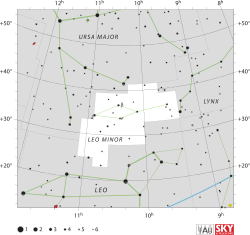| Observation data Epoch J2000.0 Equinox J2000.0 (ICRS) | |
|---|---|
| Constellation | Leo Minor |
| Right ascension | 10h 27m 53.000s[1] |
| Declination | +36° 42′ 25.96″[1] |
| Apparent magnitude (V) | 4.21 (4.40/6.12)[2] |
| Characteristics | |
| Spectral type | G9III[3] |
| U−B color index | +0.64[2] |
| B−V color index | +0.90[2] |
| R−I color index | +0.46[2] |
| A | |
| Spectral type | G8III-IV[2] |
| B | |
| Spectral type | F8IV[2] |
| Astrometry | |
| Radial velocity (Rv) | 8.52[4] km/s |
| Proper motion (μ) | RA: −127.68[1] mas/yr Dec.: −110.31[1] mas/yr |
| Parallax (π) | 21.19 ± 0.50 mas[1] |
| Distance | 154 ± 4 ly (47 ± 1 pc) |
| Absolute magnitude (MV) | +0.85[4] |
| Orbit[5] | |
| Period (P) | 13,965±40 |
| Semi-major axis (a) | 0.3782″±0.0007″ |
| Eccentricity (e) | 0.680±0.002 |
| Inclination (i) | 81.4±0.1° |
| Periastron epoch (T) | 2451411.1±4.8 JD |
| Argument of periastron (ω) (secondary) | 215.7±0.2° |
| Semi-amplitude (K1) (primary) | 7.93±0.05 km/s |
| Semi-amplitude (K2) (secondary) | 12.32±0.18 km/s |
| Details | |
| A | |
| Mass | 2.98±0.10[5] M☉ |
| Radius | 9.4±0.3[5] R☉ |
| Luminosity (bolometric) | 50.7±1.8[5] L☉ |
| Surface gravity (log g) | 2.85[4] cgs |
| Temperature | 4,097±927[5] K |
| Metallicity [Fe/H] | +0.09[4] dex |
| Rotational velocity (v sin i) | 2.54[4] km/s |
| Age | 1.2[4] Gyr |
| B | |
| Mass | 1.92±0.04[5] M☉ |
| Radius | 3.7±1.5[5] R☉ |
| Luminosity (bolometric) | 9.1±4.1[5] L☉ |
| Temperature | 5,211±843[5] K |
| Other designations | |
| Database references | |
| SIMBAD | data |
Beta Leonis Minoris, Latinized from β Leonis Minoris, is a binary star in the constellation of Leo Minor. It has an overall apparent visual magnitude of approximately 4.2. Although it is the only star in Leo Minor with a Bayer designation, it is only the second brightest star in the constellation (the brightest is 46 Leonis Minoris).[8]
- ^ a b c d e Van Leeuwen, F. (2007). "Validation of the new Hipparcos reduction". Astronomy and Astrophysics. 474 (2): 653–664. arXiv:0708.1752. Bibcode:2007A&A...474..653V. doi:10.1051/0004-6361:20078357. S2CID 18759600.
- ^ a b c d e f g HR 4100, database entry, The Bright Star Catalogue, 5th Revised Ed. (Preliminary Version), D. Hoffleit and W. H. Warren, Jr., CDS ID V/50. Accessed on line October 1, 2008.
- ^ Keenan, Philip C.; McNeil, Raymond C. (1989). "The Perkins Catalog of Revised MK Types for the Cooler Stars". The Astrophysical Journal Supplement Series. 71: 245. Bibcode:1989ApJS...71..245K. doi:10.1086/191373. S2CID 123149047.
- ^ a b c d e f Deka-Szymankiewicz, B.; Niedzielski, A.; Adamczyk, M.; Adamów, M.; Nowak, G.; Wolszczan, A. (2018). "The Penn State - Toruń Centre for Astronomy Planet Search stars. IV. Dwarfs and the complete sample". Astronomy and Astrophysics. 615: A31. arXiv:1801.02899. Bibcode:2018A&A...615A..31D. doi:10.1051/0004-6361/201731696. S2CID 85526201.
- ^ a b c d e f g h i Cite error: The named reference
Wang2020was invoked but never defined (see the help page). - ^ Entry 10279+3642, The Washington Double Star Catalog Archived 2008-04-13 at the Wayback Machine, United States Naval Observatory. Accessed on line October 1, 2008.
- ^ HD 90537 -- Spectroscopic binary, database entry, SIMBAD. Accessed on line October 1, 2008.
- ^ Cite error: The named reference
kalerwas invoked but never defined (see the help page).
